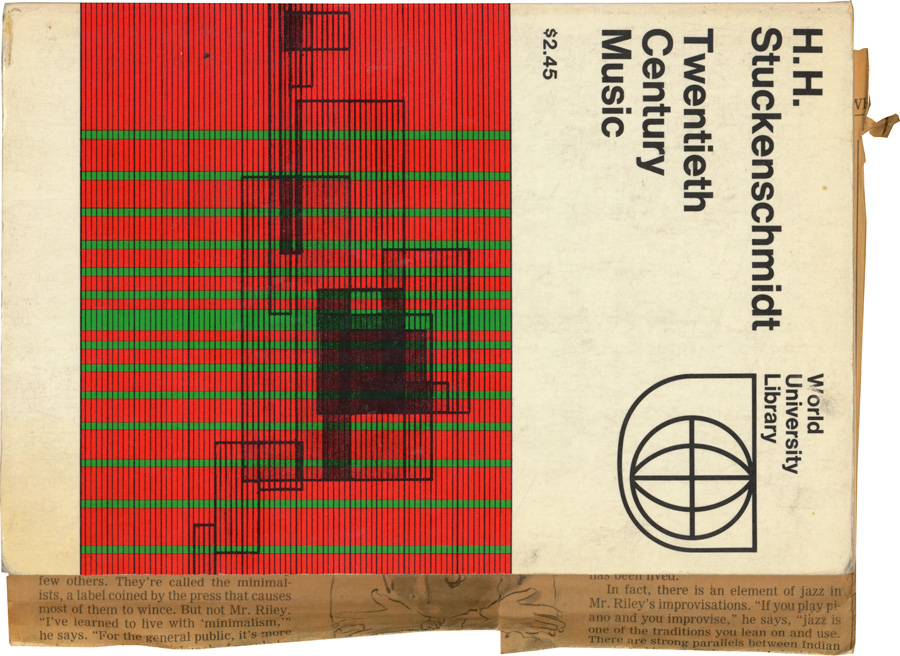tuning the ears

H. H. Stuckenschmidt. Twentieth Century Music.
Translated from the German by Richard Deveson (New York: McGraw Hill, 1969)
My early vade mecum through modern music, purchased around time of publication. I still refer to my copy — falling apart, but pages all present — pulling it from a shelf that also holds neglected books by Adorno, Carl Dahlhaus, Charles Rosen, Edward Said, Stockhausen.
Berg, Schoenberg, Webern. Hindemith, Messiaen, Boulez, Stockhausen — all are here. Shostakovich. Bartok and Kodaly. John Cage, Hans Werner Henze, Edgar Varèse, Iannis Xenakis. Even Ärvo Pärt, whose In Perpetuum Mobile is mentioned, and that I heard broadcast on KPFK radio one Sunday morning (when? 1970?), on the Music Not for Export show. Los Angeles was good for music — I remember the Contempo 71 series put on by the Los Angeles Philharmonic (and wrote it up, at considerable and pompous length, in my high school newspaper). Contempo 71 introduced me to Hans Werner Henze (Five Neapolitan Songs), Peter Maxwell Davies (Julius Eastman singing Six Songs for a Mad King), Thea Musgrave (Clarinet Concerto), others.
How is it I made myself available to this music? A tangled mix of pretense and predisposition, I suppose, and inputs: in addition to Stuckenschmidt there was Zappa of course, and radio (KPFK above all). Los Angeles, again: heard Terry Riley perform at Caltech one year, and Yvonne Loriod perform Messiaen’s Vingt regards sur l’enfant-Jésus another (the composer was present). Ah, and Stanley Kubrick’s 2001 A Space Odyssey (1968), e.g., György Ligeti his Atmosphères. Nicholas Slonimsky (1894-1995) was around, talking on the radio. I looked at but didn’t read his books on music, including his Lexicon of Musical Invective (1953), and remember his short essay on the record jacket to Christiane Edinger’s recordings of Bach’s violin sonatas and partitas (years later, I would hear her perform that music in Tokyo and, later, in Yokohama).
This book provided a narrative — a smart, sympathetic treatment — and visuals: photographs, paintings, scores. Many of the scores are graphic, new grafts in my evolving personal aesthetic. (The cover shows a detail from the electronic score of Stockhausen’s Studie II (1954)).
Good chapter titles: (1) Romanticism and anti-romanticism; (2) Emancipation; (3) Noise and timbre; (4) Simultaneity; (5) New means of organisation; (6) Revisions and reversions; (7) The music of commitment; (8) Folk-music and exotic music; (9) Technical sound-material; (10) Mathematics — for and against; (11) Years of experiment; (12) Consolidation.
Another feature of the book was the 8-page chronology in back, music at left, a less (and-less) populated column of “related arts” at right, beginning with Janacek’s birth (1854) and ending with Barraqué, Chant aprés chant (1966).
Stuckenschmidt holds up well, doesn’t retail a single trajectory for this music. Of course, it’s centered on the Euro-North-American world, for the most part. Japan (Takemitsu), Mexico (Carlos Chavez) are mentioned, the latter only in relation to “an autochthonous folk-music,” in a context in which folk-material is discussed for its suitability to twelve-tone and serial techniques, but no matter (I found other musics on my own). And it’s mostly males (plenty on Pierre Schaeffer and his group, but no Éliane Radigue). But along with other inputs, it played a salutory part in tuning my ears, making them available to the broad spectrum that includes silence, static, and the musical equivalent of “conceptual” writing. (July 2019 : actually, Stuckenschmidt, and the serial and other kinds of music discussed in this book, probably inclined me to be receptive — much later — to experimental writing (and reading)).
—
old clippings inside
- “Terry Riley: Maximizing Minimalism” (The Wall Street Journal, 12 February 1997);
- the New York Times obituary of Witold Lutoslavski (9 February 1994); and
- “In a Quest for Creativity, Some Shell Out $20 to Listen to Static” (The Wall Street Journal, 13 April 1990 — second part, the first-page beginning is missing, about Maryellen Visconti her “Mind Gym”).
note —
These (slightly edited) comments taken from a catalogue of books with personal significance, that I undertook to write/design along with my students (to whom I assigned the exercise, in Forms and Cultures of the Book, Spring 2012). Never finished mine. It draws in part on ruminations on my early listening, at radio aves.
tags:
listening; tunings; vade mecum; H. H. Stuckenschmidt, Twentieth Century Music (1969)